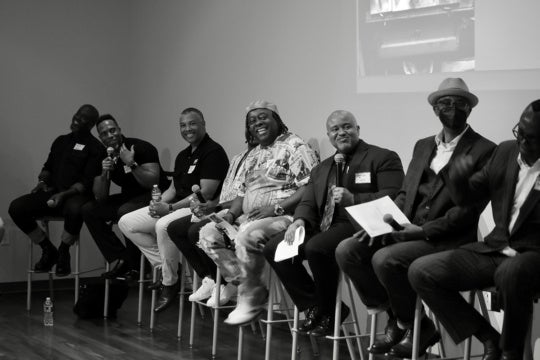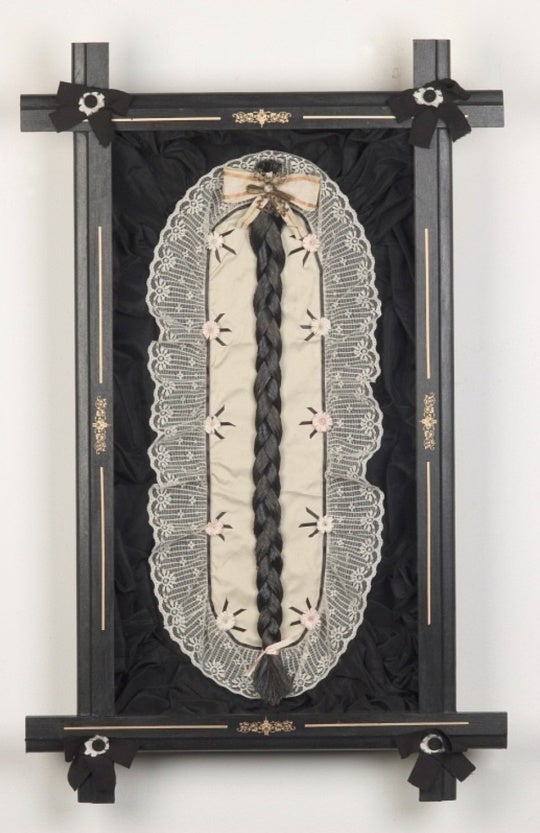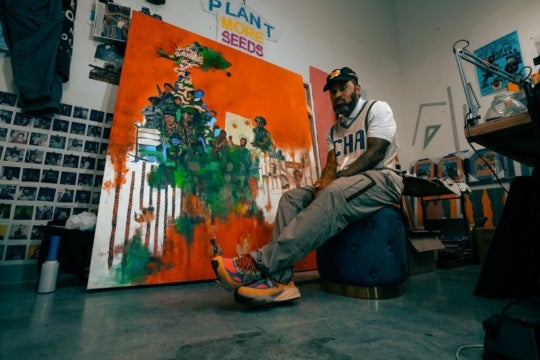
There’s just something about watching children express wonder. On this hot Friday, I’m watching a few kids run around the Music Box Roving Village as if it is a playground. Rain is due to fall at any moment, according to the weather forecasters, but right now the sun is out and there’s a young girl talking into the receiver of a pay phone, her voice broadcasting over the twirling loudspeakers on top of the booth.
I don’t even need to tell this girl running around that she’s in an artwork; if it is a playground to her, then it is a playground. The Music Box Roving Village, on view through May 10, is a grouping of musical sculptures organized by New Orleans Airlift that reopens adult imaginations to the sources of wonder in our world. Take Darryl Reeves, for instance, an artisan of metals who runs Andrews Blacksmith Shop, where he makes things like steel gates for architects. He’s known for historical restoration, such as the gates at the Presbytere on Jackson Square. Reeves worked on The Delphene in the Music Box Roving Village, collaborating with Swoon, whose street art also graces the rest of the compound. Swoon’s cardboard model Dithyrambalina inspired the project in the first place, and her trademark lacy patterns are obvious on the ceiling. In the course of their conversations, Reeves came up with the idea of making a musical handrail. As he was explaining this, he looked at me and mused, “Who has ever heard of a musical handrail?”
That question became a challenge to see if he could adapt his skills to this new idea. Reeves worked with lead sound artist Taylor Lee Shepherd to turn ordinary pipes into musical instruments. The end result is a kind of organ—pulling on the stops makes the railing’s pipes play various pitches. One of the highest sounds mimics the sound of the calliope used on Mississippi River steamboats. Other pipes connect to trombones in the ironwork columns that holds up the gazebo structure, serving as a link to brass bands and the importance of second line culture in New Orleans.
The Delphene sits under a big oak tree, with a waterway behind it. The setting is bucolic, and the house uses imagery that refers to the Louisiana landscape. Reeves also incorporated West African symbols known as adinkra, especially a quadruple spiral that he recalls seeing all over the city. Most people assume that the shape is decorative, but it’s actually a symbol of humility and strength.
This connection between the house and its environment is an essential point for the Music Box project, and it has a history in modern architecture, though some architects reject its significance (think International Style skyscrapers that are at home everywhere) and others insist on specific connections (Frank Lloyd Wright, Kenneth Frampton’s “critical regionalism”). The Music Box votes with the critical regionalists: its creators have traveled the world learning about vernacular architectures (such as an “outpost” built in Kiev, Ukraine). In New Orleans, the vernacular tradition is expressed in shotgun houses and Creole cottages that make up the vast majority of the urban fabric. All of the structures that make up the “Music Box” incorporate salvaged building materials and local references.

The “Music Box” project began with blighted houses in the Ninth Ward after Hurricane Katrina. In 2010, 25 artists were invited to make one house into a music box—thus the name of the project. That house fell down before it could all happen, but the materials were salvaged into the final product, which became a sensation. The “Music Box,” subtitled “A Shantytown Sound Laboratory,” was on view at the same time as Prospect.2 (2011-12). At the time, artistic director Delaney Martin and her collaborators imagined turning the temporary site into a permanent museum, but when budget issues loomed large, they realized that wasn’t going to happen. They kept the analogy of making a musical town but moved to a “roving” model. The “roving village” will move from site to site, setting up for weeks or months at a time. The analogy of the village is so important to Martin that the credits for it adopt the names of urban departments. Martin is not the curator or the director; she is the mayor. Taylor Lee Shepherd is the civil engineer. There’s a city planning commission, a Department of Public Works, Municipal Light and Power, and a Department of Signs and Signage.
The first site for the roving village is City Park, a vast 1,300-acre park in the Mid-City area of New Orleans. The village is set up in the less populated middle portion of the park, flanked by a golf course and various cultural institutions and entertainment attractions (like the New Orleans Museum of Art, a botanical garden, and an amusement park). Part of the park used to belong to the golf course, but Katrina changed all of that. Now, the area is mired in controversy; the city recently put up fences to take back the area and is hoping to turn it back into a golf course … much to the horror of many New Orleanians.

The debate over the future of the landscape at City Park colors how the “Music Box” responds to its site. The very framework of the project models the kind of cooperation that are needed to solve our environmental problems. Chateau Poulet, or the “Chicken House,” is the result of collaboration between Andrew Schrock of New Orleans and Klaas Hubner, based in Berlin. An assemblage of doors and windows, titled Resonant Memory, was made at the Goat Farm Arts Center in Atlanta, the result of prototypes developed at Georgia Tech as part of a course about musical architecture. In the finished piece, viewers can play a wooden block xylophone, open screen windows to produce noises, even “play” a chandelier of brass duck heads. The Bower’s Nest, a collaboration by Ross Harmon and Frank Pahl, was realized during a residency in Shreveport, Louisiana Large wind-chimes hang from the corners of the gazebo structure, while an autoharp is attached to the structure’s outer wall. Inside, a mirrored room holds three telephone stations, each containing various items to pluck and play.

The sound elements can be traced back to John Cage and his insistence on the musical properties of all sounds, including silence and what had been disparaged as noise. The “Music Box” instruments recall his “prepared pianos,” for which he would alter the sound of the instrument by placing nails and other foreign elements between the strings.
The Music Box does not present a readymade sound environment, but rather the instruments to make your own. Organized by the musical curator, Jay Pennington, opening weekend (April 3-4) featured a multifarious cast of musicians, including William Parker, a free jazz musician based in New York City. The choice was apt, as improvisational jazz models the kind of collaboration that the project depends on. Parker played upright bass and conducted from a star-shaped platform at the center of the site. The music ebbed and flowed like movements in a symphony, alternating between atonal noise and lyrical passages, such as Parker’s slow, bluesy duet with Tarriona “Tank” Ball of Tank and The Bangas, who was stationed in the phone booth (called Western Electric 2).

To connect to place can be a healing experience—to sit in one place and watch the sun set as the musicians were performing on opening weekend was moving. The roving village brings people together and, perhaps, restores their spirit. The north star was rising as the sky turned to dark blue at the end of the performance. Walking out, I even chanced to see the “blood moon” that occurred for only a few minutes that very night. It felt like the evening reawakened that childlike sense of wonder that we all struggle to maintain in the face of life’s difficulties.
Rebecca Lee Reynolds is an assistant professor in the department of fine arts at the University of New Orleans, where she teaches art history.




